Matador Network's Blog, page 15
August 26, 2025
This Star Party Turns a Nebraska Road Trip Into a Cosmic Adventure

I didn’t expect to fall in love with Nebraska. But as the Milky Way stretched across the sky above Merritt Reservoir near the city of Valentine, and the sound of cicadas echoed through the Sandhills, I realized the Nebraska Star Party I was attending was more than just a stargazing event — and that my time in the state would stick with me forever.
Held during the darkest, clearest part of summer, the Nebraska Star Party is an annual, days-long gathering that takes place in late July or early August, depending on when the new Moon rises. Expert astronomers and wide-eyed newcomers alike come not just to see the stars but to share them in one of the best dark-sky spots in the Midwest. The setting is intentionally remote. You’re miles from a town, surrounded by wildflowers, water, and endless skies.
Because western Nebraska has little light pollution, you could simply pull over on a back road, park beside a field, and look up to see more stars than you ever imagined. But an official star party is something else entirely. Pros set up high-powered telescopes and cameras — some of which cost more than my car — while strangers quickly become friends under the canopy of constellations. There’s quiet teaching, friendly explaining, and even impromptu sky tours from passionate astronomers who just want to share their love of the stars. Ask a question, and someone nearby will have an answer, a story, or an invitation to take a look.
One man I met had driven all the way from Tucson for the second consecutive year. After more than 30 years of chasing stars, he still ranks Nebraska among his favorite skies. Events like this take place across the country every year, hosted in remote locations where the skies remain wild and undisturbed. But when the Milky Way emerges like a glowing river overhead, you’ll understand why people drive hundreds of miles to return to Nebraska’s Sandhills year after year.
What you need to know before attending the Nebraska Star Party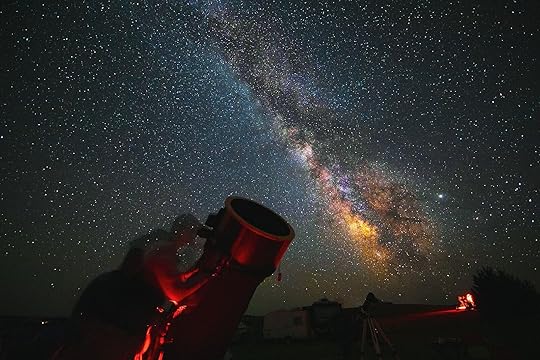
Photo: A.J. Olnes/Shutterstock
If you’re thinking about attending the Nebraska Star Party, here are a few things to know before you head into the Sandhills:
You’ll need a Nebraska State Park permit to enter Merritt Reservoir State Recreation Area. These can be purchased online or at local vendors.You also need to register for the event at this link. Registration includes access to the event site, activities, and a helpful orientation for beginners.Next year’s Star Party will be held from July 12 to 17, 2026. Plan to attend at least one evening, but many choose to camp out or attend multiple nights to catch the clearest skies.Pack bug spray. Cicadas may sing romantically in the background, but the mosquitoes aren’t shy.Even summer nights can cool down fast, especially near the water. Bring a warmer layer to stay comfortable once the sun sets.>strong>Bring snacks and water. The event is remote, and you’ll want to settle in without needing to make a run into town.Use a red light to walk around the site. White lights, such as your phone’s flashlight or car headlights, disrupt the viewing experience for everyone. Respecting the darkness is part of the magic.Even if you’re new to astronomy, you’ll fit right in. Come with curiosity and leave with a little more wonder than you arrived with.
How to plan a Sandhills road trip around the Nebraska Star Party
Left: Dobby’s Frontier Town. Right: Carhenge. Photos: Chantelle Kincy
While the Nebraska Star Party doesn’t kick off until after dark, the daylight hours aren’t just for waiting. They’re for exploring. This corner of Nebraska is full of small towns with unique personalities, and your road to the stars might just surprise you before the first telescope is even set up.
Most travelers flying in from out of state will land in Scottsbluff. From there, rent a car and set your sights on Alliance, a detour that’s well worth the few hours on the road. Alliance is one of those towns that feels like perfect small-town America. Tree-lined streets, friendly folks behind the counters, and kids riding bikes through parks. But what makes it really stand out is its offbeat, creative streak. Colorful murals pop up across downtown, and at the Carnegie Arts Center, rotating exhibits feature local and regional artists, as well as offering space for classes for kids to learn to express themselves through artistic mediums.
Just outside of town, you’ll find a different kind of creativity at Carhenge, a quirky, full-size replica of Stonehenge made entirely from old cars. It’s equal parts sculpture garden, art installation and quirky photo op. Elsewhere, a walk through Dobby’s Frontier Town offers a step back in time with a collection of relocated pioneer buildings that feel like a living museum, bringing the Old West to life. Don’t miss the saloon, schoolhouse, and jail.
When you need a bite, stop by Hug in a Mug, where small-town warmth is served in a to-go cup. This cozy café is the perfect spot to stop for breakfast before visiting Carhenge or exploring downtown Alliance, with solid coffee and a little gift shop vibe that makes it feel like a find.
From Alliance, as you make your way closer to Merritt Reservoir, you’ll pass through Valentine, a place that bills itself as “small town, big adventures” and somehow still manages to exceed expectations. Waterfalls, scenic trails, and wildlife encounters make it a dream come true for outdoor lovers. It’s also home to some of the friendliest locals I’ve ever met.

Left: Smith Falls. Right: Golden Prairie Bison. Photos: Chantelle Kincy
Take your time getting to know Valentine’s outdoors, starting with the Cowboy Trail. Spanning across northern Nebraska, the Cowboy Trail is one of the longest rail-trails in the country. From Valentine, ride or walk to the Trussel Bridge for panoramic views over the Niobrara River. If you’d rather get out on the water, considering kayaking or tubing the Niobrara River. Paddle through scenic gorges, under historic bridges, and past waterfalls you can walk behind. Smith Falls, Nebraska’s tallest waterfall, is a must-stop spot along the route, and the whole float is peaceful and refreshingly uncrowded.
Another waterfall, Fort Falls, awaits a short, scenic hike from Fort Niobara, a former military outpost turned wildlife refuge that’s home to bison, elk, and prairie dogs. Just outside of Valentine, you can get up-close and personal with the fauna at Golden Prairie Bison, a family-run ranch that gives you the rare chance to hand-feed bison while learning about their land, history, and conservation efforts.
Between excursions, Valentine has several worthwhile food stops. In the morning, locals line up at Old Mill Deli for burritos, baked goods, and gourmet coffee that rivals any big-city café. Grab a seat if you can, or take your breakfast to go and enjoy it beside the river.
Bulldoggers BBQ is a veteran-owned spot that doesn’t even own a freezer — everything is made fresh, from the brisket to the scratch-made sauces. Founded by the mayor and brewed by a Pacific Northwest transplant, Bolo Beer Co. feels like the town’s living room. On Fridays, the smoker rolls out with something new each week — I got lucky with a smoked gyro that was outrageously good.

Niobrara Valley Vineyards. Photo: Chantelle Kincy
For something a little more sophisticated, head to The Prairie Club golf course. You don’t have to play a round to enjoy dinner here (though the pristine fairways and big skies might tempt you). The food is upscale without being fussy. Go for the steak or whatever the chef is featuring that night, and soak in the Sandhills views while you eat. Of course, if it’s sunset views you’re after, it’s hard to beat the award-winning pours at relaxed, rustic Niobrara Valley Vineyards.
Valentine also plays host to a great home base for Sandhills adventures. Right in the heart of town, the Niobrara Lodge has clean and cozy rooms, welcoming staff, and a location that promises you’re never more than a few minutes from trails, food, or starry skies. If you’re flying into or out of the area, Fairfield Inn & Suites Scottsbluff is another name to know. It’s a convenient and comfortable stopover with all the expected amenities — plus, it’s just a short drive from Scotts Bluff National Monument if you’ve got time to spare.
Getting to and around the Sandhills
Merritt Reservoir State Park. Photo: Chantelle Kincy
The easiest gateway is Scottsbluff Regional Airport (BFF). From there, you’ll want to rent a car. Driving is essential here, not just for convenience but because the journey itself is part of the charm. Expect long stretches of open road, rolling prairie, and the occasional “Did you see that?” roadside oddity.
You won’t find public transportation out here, and honestly, you wouldn’t want to. This is road trip country. Bring a good playlist, fill the gas tank, and let the Nebraska backroads lead you somewhere unexpectedly beautiful. 
Best fall foliage not in New England

When people picture fall foliage, New England usually takes center stage — but the most dazzling displays stretch far beyond Vermont’s covered bridges or Maine’s country roads. Across the US, mountain ranges, lakefronts, vineyards, and even high deserts burst into color each autumn, painting landscapes in shades of crimson, gold, and fiery orange. From the Appalachian ridges of Tennessee and West Virginia to the canyons of New Mexico, the vineyards of California, and the waterfalls of the Pacific Northwest, here are eight underrated places where fall delivers a show every bit as unforgettable as New England’s famous leaves.
More like thisTravelPlanning a Fall Foliage Trip? Here’s Why Colors Vary in Each US Region and What to ExpectSmoky Mountains, Tennessee
Photo: NaturalStock/Shutterstock
Covering more than 500,000 acres across Tennessee and North Carolina, Great Smoky Mountains National Park is the most visited national park in the US, drawing more than 13 million people each year. It’s home to some of the highest peaks east of the Mississippi, a dense network of trails, and wildlife ranging from elk to black bears — and in the fall, the mountains turn into a weeks-long spectacle of color.
Because the leaves change first at higher elevations in late September and later at lower elevations through the end of October, you get one of the longest foliage windows in the country. The trees themselves also vary with altitude, so you’ll see different tones above and below 4,000 feet. The best way to take it in is on foot, following trails that lead through forests lit up in the colors of carrots, lemons, and wine to viewpoints where the whole range spreads out before you.
If you want the full mountain experience, check out these Smoky Mountain cabins — from rustic hideaways tucked in the trees to modern retreats overlooking the ridges. Each one makes a perfect base for exploring the park’s trails and viewpoints.
New River Gorge, West Virginia
Photo: Sean Pavone/Shutterstock
Designated a national park and preserve in 2021, West Virginia’s New River Gorge is one of the newest additions to the US national park system — and one of its most underrated. Carved by the ancient New River and framed by sheer sandstone cliffs, the gorge is beautiful year-round, but fall transforms it into a riot of color.
A mix of beech, birch, sumac, locust, and oak trees paint the canyon walls in shades ranging from dusty yellow to deep claret. For one of the best views, hike the mile-and-a-half Long Point Trail to an overlook with a front-row seat to the gorge and the famous New River Gorge Bridge. Rafting and climbing are popular here too, so it’s easy to pair a day of outdoor adventure with a backdrop of blazing fall foliage. Peak colors usually arrive in the last two weeks of October.
If you want to make a trip of it, check out these cozy Airbnbs near New River Gorge, with options ranging from riverside cabins to modern lodges near Fayetteville — the lively small town just minutes from the park’s main visitor center.
Taos, New Mexico
Photo: Terry W Ryder/Shutterstock
In a state as dry as New Mexico, you might not expect fall foliage to put on much of a show. But aspen trees love high altitude, and Taos is nothing if not high. From the last week of September through early October, the area’s aspen groves light up the mountains in brilliant yellow and orange, set against the dark greens of ponderosa pines. The effect is especially striking in the Sangre de Cristo Mountains, where the crisp air makes the colors pop even more. There are plenty of ways to take it all in.
Hiking and scenic drives offer close-up views, but one of the most memorable experiences is from the air: Pueblo Balloon Company flies year-round, giving riders sweeping views of the Rio Grande Gorge and surrounding peaks. Time your visit for late October and you can catch the Taos Mountain Balloon Rally, when dozens of hot-air balloons float above the fall colors.
For a stay that reflects Taos’s blend of tradition and creativity, check out these popular Airbnbs in Taos. Options range from historic adobe homes to modern retreats framed by mountain views, all within easy reach of the town’s galleries, restaurants, and trails.
Traveling this fall? Check out Matador’s guides to the leaf-peeping season: The 14 Best Places for Leaf Peeping in United States in 2025 The Cutest A-Frame Airbnbs for a Perfect Holiday Season Escape in the Northeast 16 Haunted Airbnbs You Can Actually Spend the Night In This Halloween 16 Scenic Train Rides to See the Best Fall Foliage in the US New England’s Most Breathtaking Fall Foliage Road Trips The Most Wish-Listed US Cabins on Airbnb Aspen, Colorado
Photo: Mrs. Loh/Shutterstock
It’s no coincidence that one of the best places to see aspen trees is the town that bears their name. Aspens are the most widely distributed native tree in North America, and they thrive at Colorado’s high elevations, where entire mountainsides turn a luminous gold each fall.
The best time to catch the spectacle is from mid-September to mid-October, when groves ripple in the wind like fields of light. In Aspen and the surrounding Roaring Fork Valley, you’ll find a mix of easy-access views and deeper backcountry experiences. Independence Pass, Maroon Bells, and Castle Creek Road all offer unforgettable drives framed by glowing stands of aspens. If you prefer to get out on foot, trails near the Maroon Bells or Smuggler Mountain put you right among the trees, where the crunch of fallen leaves is part of the experience. With wildfire risk increasingly shaping the landscape here, locals note that the colors can peak quickly — so it’s worth planning a flexible trip.
When it comes to where to stay, Aspen lives up to its reputation as a glamorous mountain town. Check out these stunning Aspen Airbnbs for everything from slopeside condos to riverside retreats, many within walking distance of the town’s dining and nightlife.
Napa and Sonoma valleys, California
Photo: Alexandra Latypova/Shutterstock
Northern California’s mountainsides may stay green year-round thanks to redwoods and pines, but in wine country, fall looks very different. From Sonoma Valley to Napa Valley, vineyard rows blaze gold as grape leaves shift with the season — a dramatic backdrop to harvest time.
Drive the Silverado Trail in Napa for sweeping views across the valley, or head to West Dry Creek Road in Sonoma, north of Healdsburg, where vineyard after vineyard glows in autumn yellow. The colors typically peak in October and often last into early November, coinciding with the grape harvest and seasonal festivals. It’s worth noting that harvest season brings big crowds, so plan ahead for tastings and scenic drives. In recent years, shifting weather patterns and wildfire seasons have added an unpredictable element, but locals say the changing landscape makes the colors — and the wines — all the more memorable.
If you’re looking for a place to stay among the vines, check out this guide to California’s must-visit wine regions, which highlights the best stays in Napa and Sonoma alongside recommendations for wineries and towns to explore. Whether you choose a chic downtown Airbnb or a vineyard-side retreat, waking up to rows of golden leaves is part of the experience.
Upper Peninsula, Michigan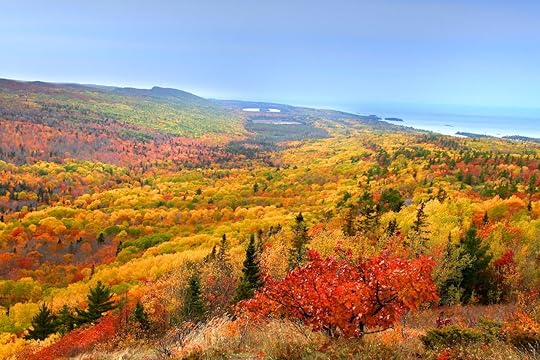
Photo: SNEHIT PHOTO/Shutterstock
To folks in Michigan, it’s no surprise that the Upper Peninsula is one of the best leaf-peeping spots in the country. Stretching between Lake Superior, Lake Michigan, and Lake Huron, the UP is vast and wild — bigger than several US states — and its forests of beech, birch, maple, oak, and hemlock light up each fall in a palette of reds, oranges, and golds.
Marquette is an ideal base, with hikes up Sugarloaf Mountain or Marquette Mountain offering sweeping views of Lake Superior backed by fiery treetops. Further north on the Keweenaw Peninsula, the scenery gets even more dramatic: water on both sides of the narrow finger of land, historic mining towns, and winding drives through tunnels of color. The Keweenaw’s Brockway Mountain Drive is one of the Midwest’s classic fall routes, with panoramic lookouts over Lake Superior. The season here comes earlier than in much of the country — late September into mid-October is usually peak time. Fall festivals and apple orchards add to the atmosphere, making a road trip through the UP as much about small-town stops as it is about sweeping landscapes.
Door County, Wisconsin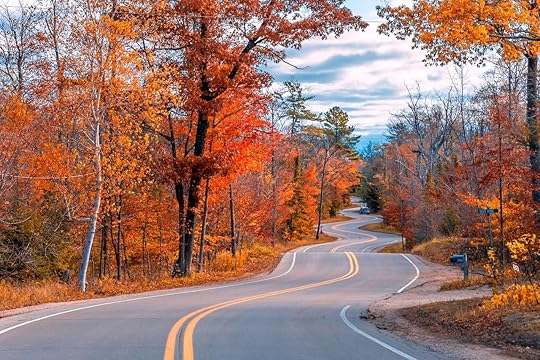
Photo: Nejdet Duzen/Shutterstock
Door County is already a perfect destination for a weekend road trip, and fall makes it even better. With spruce, walnut, and ash trees, along with countless maples and evergreens, the peninsula’s woodlands ignite in a kaleidoscope of colors.
Drive the famous Highway 42 — the road with the whimsical zigzag near Northport — or cruise the Door County Coastal Byway, looping through shoreline towns, orchards, and forests framed by Lake Michigan and Green Bay. In Peninsula State Park, you can hike the bluffs for sweeping water views, while Potawatomi State Park’s Old Ski Hill Overlook is another rewarding vantage point. The season isn’t just about the leaves. Door County’s orchards brim with apples and cherries, lavender fields add a late-season flourish, and towns like Fish Creek and Sister Bay host harvest festivals and traditional fish boils. Pair the colors with a ferry trip to Washington Island or a cider tasting at Island Orchard, and you’ll see why this part of Wisconsin has been dubbed the “Cape Cod of the Midwest.”
For a stay that matches the scenery, check out this Door County getaway guide for tips on local accommodations. The Liberty Lodge at Sister Bay is a favorite for lakefront views and a relaxed, classic Door County feel, while inns and cabins across the peninsula offer cozy bases close to trails, parks, and waterfront sunsets.
Columbia River Gorge, Oregon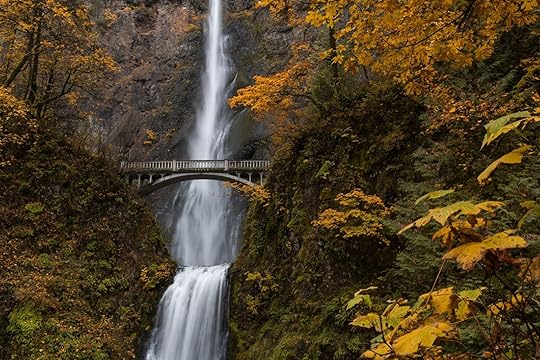
Photo: Nicholas Steven/Shutterstock
Fall in the Pacific Northwest looks different than in the rest of the country, and the Columbia River Gorge is one of the most photogenic spots to experience it. Here, big-leaf maples, Oregon ash, and cottonwoods turn golden in mid-October, lining the cliffs and riverbanks with warm hues.
What makes the scenery especially memorable are the waterfalls — Multnomah, Latourell, and Wahkeena among them — cascading through canyons framed by fiery foliage. The Historic Columbia River Highway offers some of the best leaf-peeping in the region, with viewpoints like Crown Point providing sweeping panoramas of the Gorge. For hikers, trails to Bridal Veil Falls or the climb up Angel’s Rest immerse you in the colors, with dramatic river views as a reward. The area tends to peak a little later than other parts of the country, making it a good choice for an October road trip.
For a base, look to the small towns along the Gorge. Hood River is a perennial favorite, with its mix of farm-to-table dining, craft breweries, and orchards, while Stevenson and Cascade Locks offer a quieter, small-town feel with easy access to trails and viewpoints. 
August 25, 2025
Thailand May Give Away $21 Million in Free Flights for Travelers to Explore the Country

Thailand, a country long synonymous with sun-drenched beaches, late-night city life, and affordable options for western backpackers, has found itself with far fewer foreign visitors in the first half of 2025. It reported a significant drop in foreign arrivals, pointing to competition from nearby countries, economic pressure for travelers, and safety concerns. In light of the measurable drop, Thai officials have proposed an unconventional tactic: giving away completely free domestic flights for international travelers, provided the flights meet a few broad criteria.
The plan publicly proposed by Sorawong Thienthong, the country’s Tourism and Sports Minister, proposed spending 700 million Thai baht (about $21.5 million) to buy domestic flights for 200,000-plus foreign tourists. Future visitors who book flights under the program would be eligible for free and discounted tickets to domestic destinations in Thailand once they arrive in the country. It would cover both one-way and round-trip flights, maxing out at a value of $108 per traveler. Six major carriers, such as Thai Airways, Bangkok Airways, and Thai AirAsia, have already agreed to participate, which would allow travelers to claim the free tickets at the time of booking their trips.

A beach in Ranong, one of Thailand’s least-populated provinces. Photo: Chutchawarn/Shutterstock
If passed, the program will have a few stipulations. It would only be live during the upcoming low season (September to November), and it wouldn’t work for connecting travelers between major cities, like Bangkok or Chaing Mai. The goal of the program, according to Thienthong, is to spread tourism spending around the country and encourage visitors to spend time in lesser-visited regions. Currently, Thailand has four airports that accept flights from the US. That includes two in Bangkok, one in Chiang Mai, and Phuket International Airport. But the country has more than two dozen destinations with commercial airports, from Nan and Chiang Rai in the north to Krabi and Trang to the south.
For decades, the majority of Thailand’s income from tourism has come from three provinces (Bangkok, Phuket, and Chonburi). The government hopes that it can point travelers toward overlooked destinations by subsidizing flights, potentially saving businesses like guesthouses, restaurants, and guides in regions where tourism has been fairly quiet since the COVID-19 pandemic.
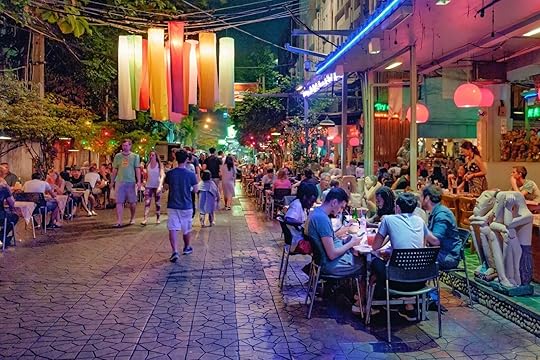
For decades, Thailand attracted ever-growing numbers of backpackers and visitors for its nightlife in big cities, among other draws. Photo: Nataliia Sokolovska/Shutterstock
According to data from Thailand’s Ministry of Tourism and Sports, 20.8 million international visitors arrived in the country in the first half of 2025. It’s a drop from the 22.4 million who visited during the first half of 2024, and makes it unlikely that the country will meet its goal of welcoming 39 million visitors in 2025. It’s nearly a seven percent drop, and a significant loss for the country: 39 million visitors would generate approximately 2 trillion baht in tourism revenue — a significant amount for a country with a GDP of 18.586 trillion baht. By comparison, nearby countries like Vietnam reported a 15 percent jump in tourism in the first half of 2025, while Japan saw a 21.1 percent increase in visitor arrivals over the same period.
The biggest drop in visitation was visitors from China, who usually make up about a quarter of Thailand’s annual visitors. Some would-be Chinese visitors have cited safety concerns, especially after the widely covered kidnapping of a famous Chinese actor, and reports of violent crime in cities. Competition is also up as countries like Vietnam and Cambodia invest in tourist-friendly infrastructure, and favorable currency exchange rates make traditionally more expensive Asian countries more affordable. Before the pandemic, tourism accounted for about one-fifth of Thailand’s GDP and employs millions of citizens in what were high-paying, reliable jobs.

A misty morning in Doi Phu Kha Naional Park in northern Thailand. Photo: Em7/Shutterstock
The program has already been announced, with the logistics set into motion — but it’s not a sure thing yet, as Thailand’s National Assembly (akin to Congress) still needs to vote on the bill. However, it’s expected to pass. Travelers from all countries are eligible (though, controversially, Thai nationals are not), and would-be travelers should check the Tourism Authority of Thailand or participating airlines’ websites for updates when they happen. A list of the exact eligible flight routes hasn’t been announced, though the Minister did note that flights would include checked baggage. 
The Trail Hotel Just Upped the Ante for Accommodations on Kentucky’s Bourbon Trail

Bardstown, Kentucky, is the “Bourbon Capital of the World” and alongside iconic attractions like a whiskey dinner train and an iconic motor lodge, its newest hotel makes getting on the liquor trail as smooth as a nip of Maker’s Mark. Standing two miles from historic downtown Bardstown, The Trail Hotel is the region’s first-ever bourbon-centric luxury property – and that even extends to the spa. Occupying the former Holiday Inn, this landmark hotel (rooms from about $190) renovation homes in on the story of the beloved spirit and exactly why Kentucky bourbons are the undisputed best. A giant copper still dominates the lobby, suites are whiskey-themed, and a silky bourbon-inspired palette accents the resort. As for guests who sail past their limit, IV treatments in the Rejuvenation Room are a neat trick for the morning after.
We hope you love The Trail Hotel! Just so you know, Matador may collect a small commission from the links on this page if you decide to book a stay. Listed prices are accurate as of the time of publication.
Immersive bourbon experiences at The Trail Hotel
Photo courtesy The Trail Hotel
Perhaps the most luxurious service available at The Trail Hotel, the Bourbon Butler acts as your personal liaison between Bardstown’s liquor businesses. Drop them a note over email ahead of arrival to rustle up a bespoke itinerary across distilleries, farms, and restaurants. The hotel runs shared half-day and full-day bourbon tours while private excursions combine tastings with a spot of golf or horseback riding.
Closer to home, the Bourbon and Bunkers at The Trail Hotel stages a refined golfing experience with a private bar stocked with Kentucky bourbons. Continue the conversation at Bourbon Alley, an al fresco cigar lounge with private fire pits, Adirondack chairs, and premium cocktails. Of course, it wouldn’t be a bona fide whisky-themed hotel without some moonshine splashed into a craft cocktail. Get into cahoots with the front desk and you might find yourself on the list for the Speakeasy-styled Bourbon Vault.

Photo courtesy The Trail Hotel
It’s not all booze; take the pressure off your liver at the hotel’s signature restaurant, Oak & Ember, where Southern fare gets a posh twist. You’ll be in safe hands with steak frites or mellowing out over the single barrel seafood platter. When that inevitable hangover makes itself known, a trip to the Rejuvenation Room will soon righten a sore head. This wellness center has IV Therapy stations and an oxygen bar to courteously see away the telltale signs of one too many. Otherwise, a three-minute cryotherapy session provides a speedy reset after a night on the liquor and works wonders for overall health.
Bourbon-themed accommodation at The Trail Hotel
Photo courtesy The Trail Hotel
Out of the 95 guest rooms, eight unique suites are themed around Kentucky’s bourbon production and heritage. The Still Suite pays homage to copper’s role in the distillation process whereas Cooperage Suite celebrates the white oak vessels favored for barrelling in Kentucky. Besides being beautifully attired for a relaxing weekend away, these suites furnish your stay with an education on Bourbon Country’s history through vintage photography and relics. Standard rooms follow a similar aesthetic to the suites with wood-paneled walls, springy carpets, and chic bathrooms.
The best rooms have patios or direct access to the resort-style pool, which has loungers and poolside service. Non-guests are welcome to swim, subject to a fee, which means you might even pick up some insider recommendations from the hospitable local community.
Other bourbon experiences in Bardstown
Photo courtesy The Trail Hotel
It would be easy to spend the whole trip lounging by the pool and working your way through the hotel’s bourbon menu. But, seeing as this small town has the world’s highest concentration of bourbon distilleries on its doorstep, you’ll want to get out and see how Bardstown’s mixologists are interpreting the goods.
Owned and managed by Bardstown-born Whitney Rye, The Parlor Room is a cherished downtown watering hole offering intimate tastings and masterclasses rooted in storytelling. Rye curates her workshops with care, covering pioneers from bourbon’s local heritage and reimagining classic cocktails. Featured pours include the likes of Elmer T. Lee Single Barrel and Weller Special Reserve. Budding bourbon enthusiasts and connoisseurs alike are welcome.
Cocktails are presented with theatrics at Liam Ash Cocktail Emporium. Expect your libation – most but not all are bourbon-based – to appear from a cloud of smoke or with a fiery finish. And if you’re not afraid of getting your hands peaty, Bardstown Bourbon Company runs sensory blending classes where you’ll create your own water of life to take home as a memento of the Kentucky Bourbon Trail. 
From Flights to Festivals, Hemp THC Drinks Are a Legal, Easy Way for Travelers to Unwind

A familiar text from United Airlines pinged my phone: my flight back home from Phoenix had a new departure time. (Later, naturally, though “new departure time” has less baggage than “delayed” does.) I cracked open another Onward THC drink at my Airbnb and settled into a pool chair under the Arizona winter sun.
It’s never been easier to do the same almost anywhere in the country. The 2018 Farm Bill opened the door for hemp-derived THC products and sparked a wave of new drink brands. Early offerings were questionable. Few tested their products, let alone published certificates of analysis (COAs) to confirm potency and purity. That doesn’t even get into if there were any pesticides used in the actual grow. Consumers couldn’t be sure what they were drinking.
Today, major cannabis brands and upstarts alike have reliable hemp-derived THC drinks that go through the same rigorous care and testing as the cannabis sold in dispensaries. The difference? You can buy them at the same stores you pick up your wine and hard seltzers. DoorDash delivers THC drinks straight to your door in some markets, and they’re sold in major retailers like Total Wine. Even Edible Arrangements has a line of hemp-derived THC drinks.
Skip to the top THC drinks for travelersThere’s a lot to unpack about whether this is fair to the heavily regulated and state-restricted cannabis industries in the 24 states with legal recreational markets. Those products are restricted to dispensary sales and can’t cross state lines. Hemp, though technically the same plant species, gets a pass. The industry is still figuring that part out. For consumers now, the thing to know is that these so-called intoxicating hemp drinks can be purchased about as easily as buying a beer.
“The drinks are really approachable,” Jasmine Marin tells me over a call. Marin is the creative director at Cheech and Chong’s Cannabis Company — and also the daughter of Richard Anthony Marin, better known as the comedian, actor, and activist Cheech. “The low milligrams are beginner friendly. If I were to start anywhere I would start with a drink, because it’s a familiar delivery mechanism.”

Jasmine Marin. Photo: Cheech and Chong’s Cannabis Company
That familiarity has made the drinks an easy fit for travel plans. They slide naturally into social rituals once reserved for coffee, cocktails, and beer. Maybe it’s killing time before a flight, or relaxing in your hotel after a long day in the air or on the road. The cans are rarely loud about the THC content, though often have designs that resemble a trendy soda brand on hyperdrive rather than a THC product.
People who plan trips around festivals and events will likely start to see these drinks more and more. Crescent 9 THC Seltzer was an official beverage sponsor of Tennessee’s Pilgrimage Music Festival in 2024, while WYNK seltzers were the first cannabis drink partner at Chicago’s Riot Fest the same year. Nowadays had a presence at F1 Miami and Minnesota Yacht Club Festival in 2025. A THC tent beside the beer garden is no longer a stretch of the imagination.

Photo: Nowadays
For me, the appeal is simple. I like that I don’t have to trek to a dispensary to find them. The effects onset in 15 to 30 minutes, with predictable doses ranging from about 3 to 10 milligrams. That makes it easy to modulate the buzz, stacking gently over time — and unlike alcohol, there’s no hangover to deal with later.
“THC beverages are a game changer for travelers wanting a seamless, convenient way to unwind while enjoying their trip,” says Justin Tidwell, CEO and co-founder of Nowadays. “Unlike other hemp products, THC drinks require no additional equipment, are smoke-free, and are often more socially acceptable in shared spaces like hotels and concerts.”
Cheech & Chong High & Dry can be delivered via DoorDash to hotel rooms or picked up in Total Wine, grocery stores, and Circle K. Nowadays is available through those same channels, and is also directly connected to travelers with placements in hotel minibars like at Palm Tree Club Miami.
The numbers suggest more than a passing trend. The analytics and research firm Euromonitor International estimated the hemp-derived THC beverages industry to be worth $239 million in 2023. It projects that by 2028, that will increase 1,615 percent to $4.1 billion. Part of that will come from wellness travelers, people hitting the road for festivals and events, and anyone who is looking for an alternative to alcohol as a social way to relax. (As well as anyone who has used the term “California sober.”)

Photo: Woodstock
The drinks also align with the booming functional-beverage trend. Beyond THC, some brands add adaptogens or nootropics for targeted effects. Woodstock’s lineup, for example, blends THC with minor cannabinoids like CBG and CBN, plus L-theanine (the amino acid in green tea that promotes calmness) and mushrooms such as lion’s mane, reishi, and cordyceps for mood-based benefits. Upward, a sister brand of Onward, has cans with 100 milligrams of caffeine as well.
Still, that hemp-derived THC drink future isn’t guaranteed. The 2018 Farm Bill is up for review, and some lawmakers want to close what they see as a hemp loophole. Several states already ban hemp-THC drinks outright — including Colorado, California, and Missouri, which all have recreational cannabis. Other states, like Arkansas, cap each container at a single milligram of THC.
That technically means you can purchase a drink at a grocery store in one state and be afoul of the law on a road trip to one state over. The TSA doesn’t search for drugs, and states on its website that products that adhere to the 2018 Farm Bill are fine to fly with. But if they spot something during a screening that conflicts with local law, they “refer the matter to a law enforcement officer.”
And despite the hype, hemp-derived THC drinks are simply less familiar to people who may be interested. “Many consumers in the US don’t understand that these drinks are legal in their state and available outside of dispensaries,” Tidwell says. “Education is a big part of breaking through.” Though what’s available at a Total Wine in Florida might not be on shelves in Texas, and rules could shift again by the time you board your next flight.
For now, the drinks remain pretty widely accessible. Nowadays alone is sold in more than 10,000 retail locations and ships to over 40 states. “Stories from customers packing Nowadays for friend trips and outdoor adventures show strong opportunity for a future where THC drinks are as common as alcohol in travel settings,” Tidwell adds.
It’s not too hard to imagine a future where hemp-derived THC drinks are available at some airport bars.
“That would be a lot chiller than alcohol,” Marin says with a laugh. “I don’t know if you’ve been next to a drunk guy on the airplane. It’s pretty stressful. But if you’ve ever been next to a really high person on the plane, they’re just laughing. They might need some extra water and more snacks.”

Photo: Cheech and Chong’s Cannabis Company
As with any THC product, start low and go slow. Full effects can take up to an hour, and these drinks are low-dosed for easy and spaced-out sessions.
The best hemp-derived THC drinks for travelersOnward and Upward
Photo: Onward
Where it’s available: Total Wine, ABC Fine Wine & Spirits, and Shores Fine Wine & Spirits in Florida (store locator). Ships to 35-plus states.
The drinks that started it all for me. Onward leans into cocktail-inspired flavors at 3 milligrams (Peach Bellini, Italian Spritz), 5 milligrams (Blueberry Mojito, Sea Salt Margarita), and 10 milligrams (Passion Fruit Martini) of THC. The spritz and margarita are personal favorites. Effects hit 10-15 minutes after drinking, and the drinks are made with natural juices and no high-fructose corn syrup. A new sister line called Upward combines 5 or 10 milligrams of THC with 100 milligrams of caffeine in flavors like Peach Nectarine, Strawberry Tea, Lemonade, and Pink Lemonade. Both are part of the cannabis company Trulieve, and the drinks are third-party lab tested.
Nowadays
Photo: Nowadays
Where it’s available: More than 10,000 retail locations in 30-plus states (store locator). Presence in select hotels and at events. Ships to 40-plus states.
I can pick a few favorite flavors out of the lines from other THC drink brands. With Nowadays, there’s no bad or even mediocre option. Tropical, Berry, Citrus, Spicy Lime, and the limited-run Lemonade all taste better than even the best seltzer of any kind in my opinion. The cans are obviously convenient for travel, but the company started with bottles designed to be used similar to how you would a shot of liquor mixed into a cocktail. Then there’s the 2-ounce shot: 5 or 10 milligram doses in a pocket-sized bottle that’s perfect for on-the-go.
Cheech & Chong’s High & Dry and High Teas
Photo: Cheech and Chong’s Cannabis Company
Where it’s available: Circle K, Total Wine, ABC Fine Wine, and more retail locations in 25-plus states (store locator). Ships to 40-plus states.
High & Dry is exactly what you’d expect from Cheech & Chong: playful, approachable, and well-crafted. The lineup includes cocktail-inspired 5-milligram seltzers like Magic Mule, Raspberry Highball, and Citrus Sunrise, alongside fruity options such as Wondermelon and Mango Fizz. My favorites are the 10-milligram “High Teas” — Tommy Palmer and Cheech’s Peaches — which are like a better tasting AriZona Iced Tea with a good dose of THC. The iconic cannabis culture and advocacy duo could have slapped their name on anything and found a customer base. These quick-hitting drinks show more genuine product care than that.
Woodstock
Photo: Woodstock
Where it’s available: Stores in Illinois, Tennessee, New Jersey, Connecticut, Ohio, Kansas, and Missouri (store locator). Ships to 30-plus states.
Announced ahead of the 56th anniversary of the legendary 1969 Woodstock, the official Woodstock festival brand launched a line of cannabis-infused seltzers that channel the same peace and love spirit of the iconic event. Each low-dose can blends THC with minor cannabinoids and functional mushrooms for tailored effects. Citrus Spritz (“Laugh”) and Yuzu Ginger (“Chill”) have just 2.5 milligrams of THC as well as the cannabinoids CBC, CBG, and CBD, along with varying combinations of L-theanine, cordyceps, lion’s mane, and reishi. The 5 milligram THC Raspberry Lychee (“Solace”) and Dark Berries (“Dream”) use different combinations of the same functional mushrooms and have higher amounts of CBD as well as CBG and CBN (a cannabinoid known for sleepy effects). The lighter options are the ultimate sessionable THC drink, and have a taste that’s highly amenable to drinking a few in a single sitting. 
Fall foliage hot-air balloon rides

Leaf peeping is like a masterclass in color theory. Up close, autumn’s trees look like paint palettes daubed with bright, warm acrylics, and fallen leaves look like little brushstrokes on the earth. A bird’s-eye view, on the other hand, paints the whole autumnal picture, transforming the fiery fall landscape into a mural that stretches as far as the eye can see. This year, spice up leaf-peeping season by taking in the scenery from the basket of a hot-air balloon soaring high above the trees. From New Mexico to New York, stick to these ballooning hotspots for a panoramic fall foliage experience you’ll never forget.
Green Mountains, Vermont
Photo: B Brown/Shutterstock
The Green Mountains are, in fact, green for much of the year. Once summer starts to fade away, however, they take on leaf-peeping season’s fiery color scheme. Highlights of a hot-air balloon ride over the range, which belongs to the greater Appalachian Mountain range system, include gliding over Lake Champlain and trying to spot wildlife like moose, deer, and bears while letting the wind carry you overhead. If you can, organize a trip to the Green Mountains and a balloon ride with Above Reality Hot Air Balloon Rides of Vermont this October. Trust us.
Albemarle County, Virginia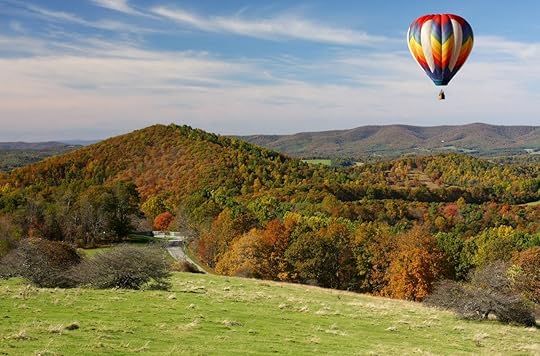
Photo: Steve Bower/Shutterstock
Albemarle County might not ring a bell, but its claim to fame and Thomas Jefferson’s former home, Monticello, probably does. Monticello Country Ballooning launches from various sites in and around Charlottesville, where the fall foliage is spectacular, especially in mid-October. While both sunrise and sunset flights are possible year-round, leaf-peeping hopefuls should opt for a sunrise ride to see the foliage ablaze in the first light of morning.
Letchworth State Park, New York
Photo: Jim Vallee/Shutterstock
Nicknamed the “Grand Canyon of the East,” Letchworth State Park seduces visitors year-round with its waterfalls, rock walls, and dramatic Genesee River Gorge. Surrounding it all are ancient trees that absolutely stun when dressed in their fall best. The only balloon company licensed to take off from within the park, Balloons Over Letchworth launches its riders a stone’s throw from Middle Falls. As a bonus, riders will catch a glimpse of the Genesee Arch Bridge, a 235-foot railroad trestle, as they fly over Upper Falls. The weather can be fickle in October when the foliage is at its peak, so be sure to consult your weather app before booking.
Traveling this fall? Check out Matador’s guides to the leaf-peeping season: The 14 Best Places for Leaf Peeping in United States in 2025 The Cutest A-Frame Airbnbs for a Perfect Holiday Season Escape in the Northeast 16 Haunted Airbnbs You Can Actually Spend the Night In This Halloween 16 Scenic Train Rides to See the Best Fall Foliage in the US New England’s Most Breathtaking Fall Foliage Road Trips The Most Wish-Listed US Cabins on Airbnb Taos, New Mexico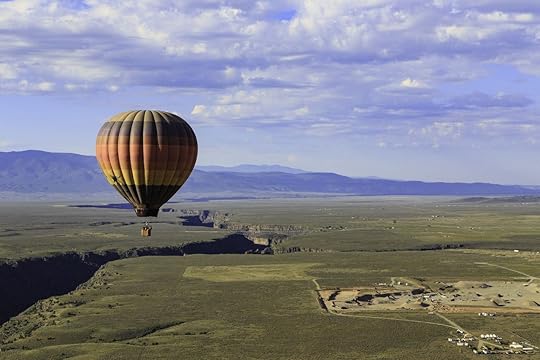
Photo: karengesweinphotography/Shutterstock
Albuquerque takes its ballooning seriously with an annual International Balloon Fiesta, but if leaf peeping is your priority, it’s hard to top Taos. Better known for its ski resort and historic pueblo, Taos also has a wealth of fall foliage and its own ballooning culture. Pueblo Balloon Company operates throughout the year, thrilling riders with aerial views of the Rio Grande and panoramas of the Sangre de Cristo Mountains. If you catch the ballooning bug after your ride, plan to come back October 31 to November 2 for the Taos Mountain Balloon Rally, where you can enjoy more leaf peeping from the ground — when you aren’t transfixed by the colorful hot-air balloons floating overhead.
Black Hills, South Dakota
Photo: Black Hills Balloons/Facebook
Mount Rushmore may have made the Black Hills famous, but come fall, America’s most impressive presidential bust has some competition in the surrounding scenery. The region’s ponderosa pines turn bright yellow and light orange like they’ve been dipped in sunlight. Thanks to Black Hills Balloons, you can get a bird’s-eye view of the mountains, valleys, and lakes of the Black Hills, Badlands, and Wind Cave National Park, as well as the Crazy Horse Memorial and Mount Rushmore. Champagne, light snacks, and a souvenir certificate are included.
Bucks County, Pennsylvania
Photo: The United States Hot Air Balloon Team/Facebook
Just 25 miles outside Philly, Bucks County feels worlds away from the big city, trading its skyscrapers for tall trees that make for a much nicer view, particularly come autumn. There are several ways to take in the foliage here, from walks to train rides to scenic drives, but soaking in the landscape from above is easily the most exciting. Book a ride with the The United States Hot Air Balloon Team to soar over rolling hills, farms, and vineyards dotting the tree-studded landscape. Stare out into the distance, and you might even be able to see the outline of Manhattan.
Colorado Springs, Colorado
Photo: Steve Bower/Shutterstock
Even amid mammoth landmarks like the red rock formations at the Garden of the Gods and Pikes Peak, the highest summit of the Front Range, it’s the humble aspens that steal your attention during fall in Colorado Springs when they turn a brilliant gold. Fortunately, you can see it all on a balloon ride. Adventures Out West hosts sunrise excursions that put riders eye-to-eye with the Southern Rockies and offer a whole new perspective on the trees below.
Asheville, North Carolina
Photo: Kristen Martinson/Shutterstock
Asheville is already famous for its fiery fall colors, but seeing the Blue Ridge Mountains from above in a balloon is a whole different kind of magic. Book a sunrise flight with Asheville Balloon Company and you’ll drift between 500 and 2,000 feet above Pisgah National Forest, downtown Asheville, and the rolling ridgelines that glow in autumn’s richest reds and golds. Peak fall color here stretches from early October into November, and rides fill quickly — so plan ahead if you want to see the mountains lit up in peak foliage.
Hudson Valley, New York
Photo: Photo Spirit/Shutterstock
For a quintessential fall-in-America experience, take off above the Hudson Valley, where vineyards, orchards, and the river wind through a sea of blazing maples and oaks. Each year the Hudson Valley Hot-Air Balloon Festival fills the sky with color, but you can also book a private ride for a quieter escape into the clouds. Evening flights are especially magical, when the light softens over the Catskills and the valley below seems to shimmer in shades of gold and crimson.
Lake Geneva, Wisconsin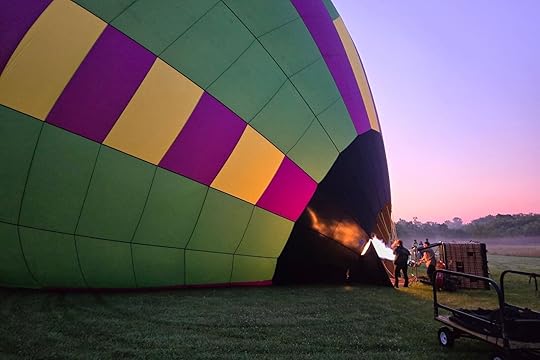
Photo: Lake Geneva Balloon Company
Fall comes later to southern Wisconsin than in New England, but by the third week of October the hills around Geneva Lake are bright with maples and oaks. From above, riders see the 20-mile Shore Path that circles the water, dotted with historic estates built during the Gilded Age, as well as farms and open countryside stretching west. Lake Geneva Balloon Company is the only operator in the region, launching sunrise and sunset flights that last about an hour and travel wherever the wind takes you. On clear days, you can spot both Milwaukee and Chicago on the horizon before drifting back toward the lake. 
August 24, 2025
Rocky Mountain hikes for foliage
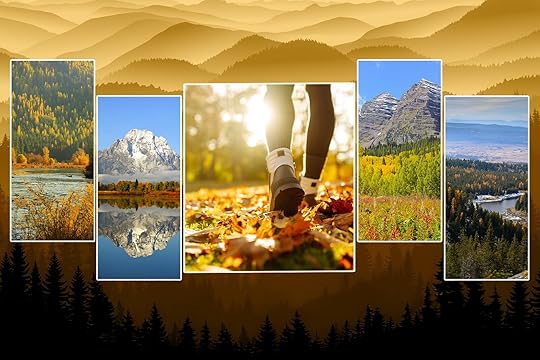
The claim to leaf-peeping fame may belong to New Englanders, but the Rocky Mountains serve up some of the country’s most dazzling spots for fall foliage. The region’s aspens and cottonwoods rival any Massachusetts maple when it comes to color. From Bozeman to Boulder, trail corridors ignite in gold and rust as the leaves turn in the Rockies. All of it plays out against mountains formed roughly 80 million years ago — and Colorado alone is home to 53 fourteeners — so the backdrop is as epic as the color. Peak timing varies by elevation — generally late September to early October — so plan accordingly. Grab your camera and your walking shoes, layer up, check the forecast and trail conditions, and start planning these stunning Rocky Mountain hikes for fall.
We hope you love the spaces and stays we recommend! Just so you know, Matador may collect a small commission from the links on this page if you decide to book a stay.
West Fork Rio Santa Barbara Trail, Carson National Forest, New Mexico
Photo: bjul/Shutterstock
Distance: 20.4 miles
Difficulty: Moderate to strenuous — gradual 3,183 feet of total elevation gain
Tucked within the Pecos Wilderness of Carson and Santa Fe National Forests just south of Taos, the West Fork Rio Santa Barbara Trail follows a steady climb through wide meadows and dense aspen groves, with the Rio Santa Barbara murmuring below. Early fall offers both live wildflower displays (typically July–August) and golden aspens late in the season. The trail gently ascends via switchbacks, opening to broad views of the Sangre de Cristo peaks, including Chimayosos. Extend your hike toward the Santa Barbara Divide and Truchas Lakes if time allows — these areas reward with alpine panoramas, though camping is sparse above treeline and prohibited within 300 feet of lakes.
Where to stay: Base yourself in Taos, less than an hour’s drive from the trailhead, where art, history, and mountain culture come together. Check out Matador’s selection of Taos Airbnbs for nearby options.
Goose Creek Falls, McCall, Idaho
Photo: Sarah Jessup/Shutterstock
Distance: Three miles in and out
Difficulty: Moderate — 685 feet of total elevation gain
Evergreen firs, spruces, and pines rise above lower foliage that flares with fall color on this trail in the Payette National Forest near Brundage Mountain Resort. Summer sees plenty of traffic here, so fall is the better season if you want the forest to yourself. Starting from the Last Chance Campground, the trail crosses small creeks and winds along well-marked paths before reaching the 60-foot Goose Creek Falls. A short scramble down to the river gives you the best perspective, looking up at the water plunging through a basalt canyon. In October, the larches add a burst of yellow to the already colorful mix.
Where to stay: Make your base in McCall, just minutes from the trailhead, with cabins and mountain retreats that put you close to both the forest and Payette Lake. Options range from angular A-frames with loft bedrooms and big windows that look into the pines, to renovated lake cabins with decks facing the water and short walks into town for dinner.
South Cottonwood Creek Trail, Bozeman, Montana
Photo: Brian A Smith/Shutterstock
Distance: 4.4 miles out and back
Difficulty: Easy — 488 feet of total elevation gain
Not to be outdone by aspens in fall, bright orange cottonwoods light up dense forests and expansive meadows on this easy trail in the Gallatin Range just outside Bozeman. If you hit the trail on a warm fall day, South Cottonwood Creek runs alongside nearly the entire way, offering spots to cool your feet. While you might not break a sweat with fewer than 500 feet of elevation gain, you can extend the outing by connecting to the History Rock or Blackmore trails. Those spurs make the area as good for a casual afternoon walk as for a longer overnight in Hyalite Canyon.
Where to stay: Bozeman is the natural base for this hike, less than 20 minutes from the trailhead. On the outskirts of town, there’s a two-bedroom place with a covered deck facing the Bridger Mountains, reclaimed timbers sourced from Glacier National Park, and custom furniture that makes the interior as striking as the views. If you’d rather stay central, there is a recently built townhome just a couple of blocks from Main Street with a chef’s kitchen, a soaking tub, and windows that frame both city streets and mountain views. It’s close enough to walk to dinner or ride the provided cruiser bikes to breweries and galleries.
More like thisEpic StaysFrom Cozy Cottages to Autumnal Cabins, These Are the Best Airbnbs in the US for FallMount Sentinel: The “M” Trail, Missoula, Montana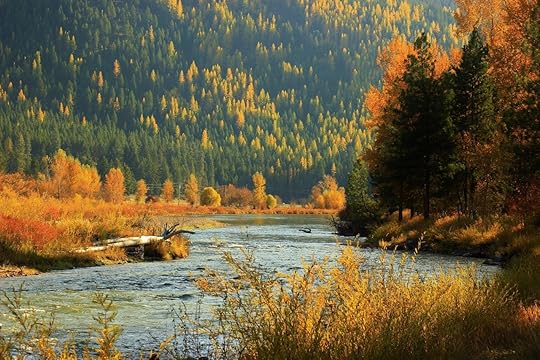
Photo: Patti Anderson/Shutterstock
Distance: 3.5 miles up and down
Difficulty: Strenuous — 11 switchbacks with 1,958 feet of total elevation gain
This hike is popular with visitors and locals alike, and the summit looks out over Missoula and the University of Montana campus. In fall, the valley bursts with a range of oranges and yellows as the leaves turn. From the top, the Clark Fork River winds through town, and mountains stretch away to the north and south. The concrete “M” replaced the original stone version built by students at the start of the 20th century.
Where to stay: Instead of staying in Missoula, base yourself in Stevensville, about half an hour from the trailhead. This stunning Airbnb is set on 10 acres at the edge of the Sapphire Mountains and gives you both privacy and big-sky views across the Bitterroot Valley. With two bedrooms and space for four guests, it works for couples or families looking to balance a day on the “M” Trail with evenings away from the city. From here, you’re well placed to explore the small towns of the valley or head south into the Bitterroot National Forest.
Taggart Lake-Bradley Lake Loop, Grand Tetons, Wyoming
Photo: Rob Marmion/Shutterstock
Distance: 5.5 miles roundtrip
Difficulty: Moderate — 585 feet of total elevation gain
This loop hike offers a huge payoff for seemingly little work. Glacial lakes reflect craggy Teton peaks, including Grand Teton itself. The peak towers nearly 14,000 feet over sagebrush and patches of forest that flame yellow and orange with autumn aspens. Along the way, keep an eye out for moose grazing near the lakeshore or black bears working the berry patches. Panoramic views of the Tetons stretch across both Bradley and Taggart Lakes, making this one of the park’s most photographed hikes. Bear spray is a must here, as the trail cuts directly through prime wildlife habitat.
Where to stay: The trailhead sits just outside Moose, but most visitors base themselves in nearby Jackson, where rentals range from modern townhouses in walking distance of the square to bigger lodges looking onto the Elk Refuge. Teton Village is another option, especially later in the season when Jackson Hole Mountain Resort begins operating. See Matador’s Airbnbs near Grand Teton National Park for more ideas on both sides of the state line.
Fern Lake Trail, Rocky Mountain National Park, Colorado
Photo: De Lorcel/Shutterstock
Distance: 7.6 miles out and back
Difficulty: Strenuous — about 1400 feet of total elevation gain
The Fern Lake Trail offers beautiful views of the valley below as it winds along the Big Thompson River before reaching The Pool, a turbulent confluence of Fern Creek and the river. The path then climbs past 60-foot Fern Falls before continuing to Fern Lake. At the northern shore you’ll see 12,000-foot Notchtop and Knobtop Mountain, while a short walk to the east side opens up a clear view of nearly 13,000-foot Stones Peak.
Where to stay: Estes Park is the closest town to this trailhead, with rentals that put you within minutes of the park entrance. Options range from hillside cabins with wraparound decks to downtown apartments within walking distance of restaurants and shops. For more, see Matador’s guide to Airbnbs in the Estes Park area, which also includes stays on the Grand Lake side of the park.
Royal Arch Trail, Boulder, Colorado
Photo: JKO Photos/Shutterstock
Distance: 3.5 miles out and back
Difficulty: Moderate to strenuous — about 1400 feet of total elevation gain
Cooler autumn days should give you more privacy on this heavily trafficked trail to the red rock arch. It may be short, but it’s no cakewalk. You’ll gain 1,400 feet of elevation through a grassy meadow and pine forest as you hike up along the base of the Flatirons. When you reach the flagstone staircase, scramble up and take in the reward: sweeping views of golden leaves spread across the Boulder Valley.
Where to stay: For a base in Boulder itself, the historic Hotel Boulderado is a standout. Opened in 1909 as the city’s first luxury hotel, it remains a landmark building on the National Register of Historic Places and a member of Historic Hotels of America. A renovation in 2018 refreshed the common areas, though the Victorian-style rooms still keep their original charm. The location, just off Pearl Street, means you can walk to Bramble & Hare for a Michelin-recognized dinner, grab a beer at Bohemian Biergarten, or head downstairs to the hotel’s own speakeasy, License No. 1. The hotel was also one of Matador’s managing editor Nickolaus Hines’s favorites of 2024.
American Lake Trail, Aspen/Snowmass, Colorado
Photo: robert cicchetti/Shutterstock
Distance: 6.4 miles up and down
Difficulty: Moderate — gradual 1,965 feet of total elevation gain
As legend has it, the Maroon Bells are the most photographed peaks in Colorado — likely a result of the parking lot at Maroon Lake, which gives tourists a hike-free payoff. On this trail, the steady switchbacks climb through aspen groves and open meadows, each turn offering wider views of the peaks, Castle Creek Valley, and the Maroon Bells Wilderness. Rest at American Lake’s shoreline for a reflection shot of the surrounding ridges, or walk a bit farther along the shore to find quieter angles.
Where to stay: Aspen is the closest base, with rentals that run from slopeside condos to sprawling mountain houses. See Matador’s roundup of Aspen Airbnbs for stays that match the town’s glamorous mountain reputation. 
Fall foliage drives in the US
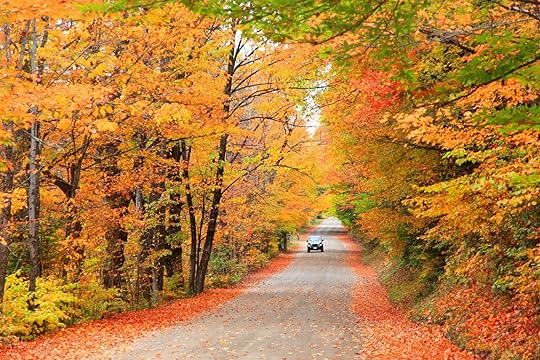
There may be no better place to be in the fall than New England. The deciduous trees covering the vast woodlands in the Northeast create stunning, bright colors that stretch for miles — and make for some of the most spectacular drives in America. The region is full of scenic routes that are perfect for a New England road trip, whether you’re spending a few days traversing the mountains of Vermont, New Hampshire, or other nearby states. While you really can’t go wrong anywhere in the region, these are the absolute best fall foliage drives in New England.
We hope you love the spaces and stays we recommend! Just so you know, Matador may collect a small commission from the links on this page if you decide to book a stay.
Route 30 — Vermont
Photo: SNEHIT/Shutterstock
Start out in historic Battleboro, driving through bright rolling hills covered in farmland, past Green Mountain National Forest — which this time of year could just as easily be called Orange, Red, and Purple Mountain National Forest. The vibrant trees pass in the distance as you get to the West Dummerston Covered Bridge, then you can stop in Newfane to do some antiquing at Jack Winner Antiques. Continue on to Grafton and Jamaica State Park, where, weather permitting, you can get out and stretch your legs with a walk along the West River.
Stay the night in Manchester, where after a visit to the former home of Abraham Lincoln’s son at Hildene, you can sleep at the Kimpton Taconic with sprawling views of the Taconic and Green Mountains. In the morning, head up the Stone Valley Byway to Lake St. Catherine State Park and see all those spectacular fall colors reflect off the water. An appropriate final stop on your journey is the Robert Frost Interpretive Trail in Ripton, where you’ll arrive armed with a newfound understanding of why he loved this region so much.
Route 112 — New Hampshire
Photo: haveseen/Shutterstock
The Kancamagus Highway — or The Kanc, colloquially — runs through New Hampshire’s White Mountains and is the best driven during October to get the full effect of the famous fall colors. Begin the drive in Lincoln and roll 37 miles through the mountains, stopping at the Bretton Woods Canopy Tour to zipline through some of the best of the autumn foliage. Continue into Franconia Notch State Park, where a much less heart-stopping aerial tramway takes you above all the orange and red. Be sure to leave time to hike through the covered bridges and epic waterfalls at Flume Gorge.
If you can, take some time to stop at Kimball Farm, where ice cream and apples will fuel you up for the next stretch. Then end your drive in North Conway, where the White Mountain Hotel and Resort offers the best lodging and a restaurant where you can enjoy classic New England flavors. Alternatively, cap the day by boarding the Conway Scenic Railway — a leisurely, historic train ride that lets you soak in the fall foliage without having to drive.
More like thisEpic StaysFrom Cozy Cottages to Autumnal Cabins, These Are the Best Airbnbs in the US for FallRoute 2 — Massachusetts
Photo: Albert Pego/Shutterstock
Known informally as the Mohawk Trail, this drive is the best way to catch the legendary fall colors in the Berkshires, traveling between the Hudson and Connecticut River valleys. Begin the drive in North Adams, a town known mostly as home to the Massachusetts Museum of Contemporary Art. It also holds an annual Fall Foliage Festival toward the beginning of October, complete with a parade. From there, head to Greenfield where a three-story lookout tower will provide the best photo-ops of the drive.
Continue into Mohawk Trail State Forest, where old-growth forest filled with maple, ash, beech, and birch trees surround your car in a blanket of bright hues. Beyond that, a couple of ziplines await at Zoar and Berkshire East in Charlemont, which is the perfect way to get some time outside the car. Or you can stretch your legs along the nature trails at High Ledges wildlife sanctuary in Shelburne. Then, cross Deerfield River in Shelburne Falls, where the water meanders through towering bright colors for the most scenic cityscape of the drive. Extend your trip by staying a night or two in a charming Airbnb barn conversion in the area.
Route 7 — Vermont
Photo: gary yim/Shutterstock
Though U.S. 7 stretches through Connecticut and Massachusetts too, it’s the scenic stretches through the Green Mountain State that make this one of our favorite fall road trips in New England. Start the route in quirky, funky, Burlington and take in the foliage on a bicycle during a Bike and Brew Tour of the city. Then begin your drive along Lake Champlain, stopping frequently to snap envy-inducing pictures of the trees surrounding the lake. Continue on to Mt. Philo State Park, where a short drive to the top of the mountain provides the most dramatic views of the drive, looking out over the lake and valley below.
Head into Middlebury, where the Otter River snakes through town flanked by brightly colored trees. Pass by the Shoreham Covered Railroad Bridge on your way to Brandon, a small town with 243 buildings on the National Register of Historic Places. Enjoy its charm before driving to Wilson Castle in Rutland, an awe-inspiring home that includes the Norman Rockwell Museum. Then pass through the Green Mountain National Forest before finishing in Bennington, a city with five covered bridges all surrounded by thick forest.
Route 7 — Connecticut
Photo: Enfi/Shutterstock
The Litchfield Hills region of Northwest Connecticut is the peak spot in the state for fall colors. Start out around Ridgefield and hit the Keeler Tavern Museum, where you’ll learn about life during colonial times and see this majestic white building contrast with the stunning trees. From there, dip into Danbury, another historic district filled with houses that date back to the 1780s.
Next is the scenic highlight of the drive at Kent Falls State Park, where you’ll hike to one of the biggest waterfalls in the state along a colorful path. Take a short detour off Route 7 to Route 128 into West Cornwall and traverse the city’s famous red-covered bridge, then take in views of autumn over the Housatonic River. If you’re feeling strong, take another detour off Route 7 onto Route 126, and you can hike a stretch of the Appalachian Trail to get the blood moving. Or make a stop in Woodbury, considered by some to be the antiques capital of New England and stay a night or two at a charming Airbnb.
Acadia National Park — Maine
Photo: f11photo/Shutterstock
Though you’ll likely be sharing it with every leaf-peeping tourist north of the Mason-Dixon Line, this 27-mile loop through one of America’s most striking national parks is still worth the traffic. Acadia National Park is at its peak this time of year, when the imposing figure of Cadillac Mountain feels a little more welcoming under a blanket of reds and yellows. Try to visit on a weekday to avoid the largest crowds. Stand among the boulders on one of Acadia’s dramatic beaches for a striking contrast between the bright fall trees and the deep blue ocean. Or take a bicycle through some of the park’s less-traveled roads.
The best time to catch the colors is around mid-October, when peak foliage and ideal hiking weather align. Assuming Mother Nature cooperates, you can hike to the top of Cadillac Mountain and see the fall colors blanketing the landscape, with sweeping views of the Porcupine Islands in the distance.
To make the most of your trip, stay nearby in one of the scenic Airbnbs near the park. Whether you prefer a cozy cabin in Bar Harbor, a retreat inside park limits, or a luxe escape in Seal Harbor or Town Hill, these stays surround you with natural beauty and keep you close to the trailheads.
Route 95 — Rhode IslandA post shared by BlackstoneValleyTourism (@tourblackstone) on Oct 23, 2017 at 12:36pm PDT
Though driving through the smallest state in America won’t take you long, this road through Blackstone Valley — the birthplace of the Industrial Revolution — packs more history and bright colors into its slice of I-95 than most American interstates.
The top attraction along the route is the Slater Mill, the first successful cotton-spinning factory in the US. After, you can hit up the Roger Williams Park and Zoo and stroll through its 435 acres of foliage and animals. If you want to see the colors from somewhere other than your car, hop aboard the Blackstone Valley Explorer Riverboat or take the Blackstone Valley fall foliage train tour from Woonsocket to Putnam, Connecticut.
For a longer trip, you can continue on to one of Rhode Island’s coastal islands and stay at one of these dreamy Airbnbs that are only a short drive and ferry ride away. Block Island is known for its bluffs, grassland trails, and weathered beach cottages that look out over the Atlantic. Or, there’s Newport, where the shoreline paths wind past Gilded Age mansions and end at the working harbor with exceptional seafood restaurants. Both are close to the mainland and make an easy way to extend a fall road trip. 
August 22, 2025
Lions by Day, Soccer by Night: The Secret Lives of Zambian Safari Guides
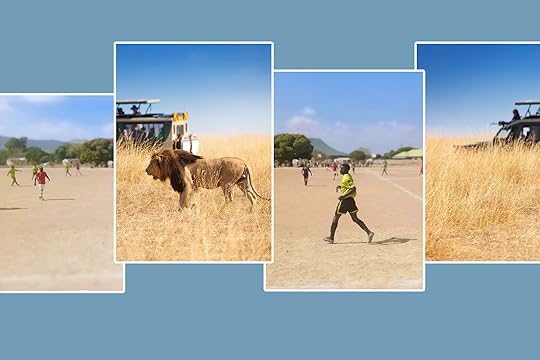
A warm wind whipped through my hair as my group drove in an open-air, khaki-colored Jeep from Mfuwe International Airport in the south of Zambia. We chatted as we got to know each other, while our guide Suzyo Zimba was at the wheel, cruising down the long main street of the village of Mfuwe. As the sunlight faded, we passed several soccer matches at full throttle. We could hear the shouts of players rising above the field, along with the muffled snorts of hippos in the nearby South Luangwa River. This was South Luangwa National Park, where the walking safari was born — and where the soccer team that Zimba runs was born, too. It’s called Mfuwe Resource Center Football Club, and had a similar start as the casual games we were driving past.
Over the coming week, I learned that Zambia’s professional safari guides aren’t just masters of the bush. Many, like Zimba, lead double lives — working as skilled, professional naturalists by day, and running serious football teams that are shaping the future of the sport in rural Africa after the tourists have gone home.
I first met Zimba on that ride from the airport as he took us to KuKaya, the first of several camps planned for my week-long trip with the Bushcamp Company. The Bushcamp Company encourages guests and guides to mingle, and I was thrilled to have Zimba as company during most meals. It’s not every day that you get to break bread with a man who’s been charged by a leopard.
One morning, I asked if he knew rugby scores from the night before, and he told me that soccer is a much more popular sport in Zambia. He told me about his team, now in Division One. It takes a beat before I realize he’s not talking about a team he follows, the same way I’d say the South African Springboks are my team. No — he actually runs the soccer team, along with Shadreck Njobvu, another Bushcamp Company guide. Over the next few days, even as we moved to new, gorgeous camps like KuKaya and Chindeni, I found myself just as fascinated by Zimba’s secret life as a soccer promoter and organizer as I was by the wildlife of South Luangwa.
“You own a soccer team?” I asked, incredulously. By that point in the trip he’d already seamlessly navigated river crossings alongside buffalo herds, kept us safe on foot within a stone’s throw of hippos, handled two mock elephant charges, found a pride of lions on the move at night, and gotten us close to two leopard brothers warring over a baboon kill. I was already wildly impressed with him as an expert guide, and was unsurprised to hear he holds the title of chairman of the South Luangwa Professional Safari Guide Association. But to know he was a professional soccer club owner on top of all that had my jaw dropping.

Suzyo, left, and Shadreck, right. Photo: Suzyo Zimba.
Zimba is quick to refute the label of him and Njobvu as club owners. “It’s not owned by an individual; it’s owned by an executive committee of Mfuwe villagers,” he tells me. “We’re all part of it. We’re proud of it.” He takes care of the team’s finances, while Njobvu is more hands-on with operational responsibilities, though they take on each other’s responsibilities when guiding duties take priority.
Zimba refers to his past clients as friends, and tells me two longtime friends from California asked him years ago how they could get more involved in the local community after their stay. The Bushcamp Company supports and leads plenty of significant community initiatives, digging wells to bring clean water to more than 75,000 area residents, building 44 classrooms in the area, and sponsoring 1,300 children and teens to finish school. Since 1999, it’s raised more than $7 million for conservation and community projects in the South Luangwa area. So Zimba felt free to think big.
Those guests wanted Zimba’s guidance and ideas, eventually turning their funding into a small community resource center. “It’s all possible because of the Bushcamp Company encouraging community development as a major project,” Zimba says. He requested that the building include a satellite dish, so young kids had a safe place to watch soccer instead of heading to a village bar, where they would be exposed to opportunities for underage drinking.
“I thought that would be most beneficial for the community,” he explains. But it was also because soccer was already booming there, as Njobvu had started a small soccer club years before. “He loves soccer even more than I do,” Zimba told me, laughing. Soon after, the duo paired up, combining the club with the resource center. In 2016, Mfuwe Resource Center FC was born. “It progressed from being a small soccer team to now competing on a regional level in Division One,” Zimba tells me with pride.

Mfuwe Resrouce Center FC. Photo: Suzyo Zimba.
I’m not sure what made Zimba prouder: when he showed me the photo of his team in their first year compared to now, or when we tagged along as he spent several hours successfully tracking male lions by their paw prints in the sand. He points at one of the teens in the photo from 2016, telling me it’s Noah, Njobvu’s son, who is now training as a naturalist guide and spotter at Mfuwe Lodge. “He’s following in his father’s footsteps,” he tells me with pride for his friend and team.
Mfuwe Resource Center FC is now in the big leagues, and with that comes more pressure. “Division One is much more competitive, playing against teams from all over eastern Zambia,” Zimba says. The team often drives up to several hours for a match, bringing supporters from the village with them when there’s space on the transport.
View this post on Instagram
A post shared by Dazzle Africa (@dazzleafrica)
Towards the end of our stay, we’re at the flagship Mfuwe Lodge, famous for the elephants that roam through the reception in search of juicy mangos. It’s here that I get to see the overlap between Zimba’s wilderness skills and soccer management skills. From our safari vehicle, we gawked as a lion pride demolished a huge buffalo, starting on the face, with the jaw bones already stripped bare. Despite growing up in South Africa, I’d never seen a kill this close.
Vehicles from various other camps had also lined up for a better look, and Zimba immediately took charge. He reminded them of the park’s viewing limitation policy to minimize the number of game drive vehicles at a single site. His voice is calm and firm, and I wonder if this is the same tone he takes with his soccer players. They didn’t get to Division One through luck, after all.

Two lions in South Luangwa National Park, Zambia. Photo: Jan Hejda/Shutterstock
Slowly, some vehicles move away. It was strangely uncomfortable to see other vehicles at all. We hadn’t seen anyone else in the area around the remote camps of Bilimungwe and Chindeni, as the Bushcamp Company is the only operator in that southern region of South Luangwa National Park.
View this post on Instagram
A post shared by Dazzle Africa (@dazzleafrica)
Fortunately, the guides’ not-so-secret lives as soccer managers are slowly coming into the light, and travelers seeking to get involved need only ask (or delve a little deeper on the website). “If they are interested and want to know more about the community or what guides are involved in, then we share,” Zimba says. “Unless guests ask, we don’t really talk about it.”
Luckily, guests tend to be the curious sort and over the years, the Mfuwe Resource Center FC has benefited from funding and donations from individuals and Dazzle Africa, providing the team with cleats, jerseys, soccer balls, and other equipment on return visits, as well as financial assistance for transportation to league away matches.
“It’s a pity you’re not here for longer,” Zimba says. “We could have gone to a match.” Turns out, match attendance is as simple as planning ahead for the right timing and then simply asking for it. There are no tickets – you just show up and enjoy the game, though you might have to forgo one of the two daily game drives to make it happen.
Zimba has big dreams for the club. “We hope to reach the national level and see our players recognized in the national team and professional clubs outside the country,” he told me as he unpacked coffee urns and freshly baked biscuits during a bush breakfast on the last game drive of the trip. We were in a clearing, with swaying branches and noisy baboons playing overhead. “The valley doesn’t offer a lot in terms of employment, but your talent can earn you a living,” he muses.
He’s excited about new developments, like a new sports complex being built in the village. “Soccer is the community itself,” Zimba says. “It brings people together. It means a lot to everyone, so we’re so proud to be playing on a professional level. It’s an inspiration to the younger generations that follow.”

Photo: Tayla Blaire
He tells me about this as I ambled about, coffee in hand, balancing on fallen tree trunks, with leaves lightly falling from the baboons’ play. Out of nowhere, a cacophony erupts and Zimba freezes, his head whipping to the side. “Into the vehicle,” he says. We clamber in as fast as we can; when Zimba says move, you move. “A leopard just made a kill. Right here, by us.” His grin widens. “One of the baboons…Do you hear them shouting? Come. Let’s find it.”
With days full of incredible animal sightings and conversations full of learning about Zimba and Njobvu’s lives as guides and soccer managers, the trip flies by. All too soon, we were en route to the Mfuwe Airport to catch our flight back to Zambia’s capital. During the drive, we passed a soccer match, ending the trip as it began it. We trudged into the airport, and while we’re reluctant to leave, Zimba is finding it hard to hide his excitement to get back to the leopard kill.
We waved farewell, departing as yet another group of his friends. I plan to return, this time with a match on the itinerary. I know a guy who can get me the best seat in the house. 
August 21, 2025
How a Windstar Cruise Around Iceland United Our Multi-Gen Family

It’s no secret within the travel industry that multi-generational vacations are soaring in popularity. A 2024 TravelPulse survey claims 49 percent of parents say they are swapping solo getaways for multi-generation family trips. When presented with different criteria they look forward to when planning multi-gen vacations, the priority was on time spent together as a family, with options for activities (54 percent), restaurants (54 percent), large accommodations/connecting rooms (45 percent) and the rare opportunity to have everyone in one place (36 percent) valued most. Plus, family vacations are no longer just for the biological children and blood relatives — spouses and significant others are invited to join the celebration.
Subsequently, according to Cruise Trade News, Gen Z is driving a multi-gen cruise boom, which meets all of these criteria. My family of six (two parents, two kids and spouses) is an adventurous group who get along well, but we live in three different states, scattered 3,000 miles across the country. We are also fortunate to have the privilege of being well-traveled, able-bodied individuals with the means and time to try something new and exciting on a trip together. After realizing we hadn’t spent time together as a unit since my wedding back in 2023, we decided to plan a family vacation that would forge some truly unforgettable memories and teach us about the world, without significantly damaging our bank accounts (or, let’s be honest, damaging our relationships with each other).
How we landed on a cruise for a multi-generational family trip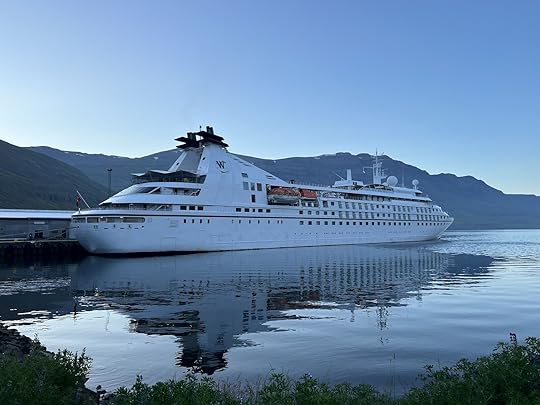
Photo: Molly O’Brien
We knew that, no matter what, traveling together would be an interesting experience since it was the first time all six of us would be traveling this extensively as a unit. And of course, as it often goes in group travel, my family features a diverse mix of personalities and interests.
My father is a wallet-conscious man who loves a tasty, well-priced meal paired with a locally sourced selection of beer. We needed to find something that offered value for our money and included an element of cultural immersion. My mother is a very particular eater and doesn’t like being stuck in one place for too long. We needed to find somewhere that’d serve good wine and food she’d want to eat, in a space where she’d never feel trapped.
My “little” brother is a large, athletic dude — and although he’s not picky when it comes to dining and drinking, as a strong, strapping six-foot-plus lad, he does need to eat more in terms of volume. We needed to find a spot that didn’t require us to find and cook the food for ourselves (because grocery stores in other countries, although extremely fascinating to me, require a fair amount more energy and effort to work for, especially when you’re hungry).
I sought a vacation that was fresh and exciting — something that would teach me about the world, and give me a chance to rest when I needed to (with opportunities to explore when I wanted to).
All of these factors pointed toward a vacation with:Plentiful (quality) dining options offered at various times of dayThe chance to embark on compelling excursionsAn environment that could balance giving us space when we needed it (but was easy enough to navigate that we’d never have trouble finding each other)A cruise ship voyage offers this and lets travelers explore a variety of new destinations on the same trip — while you conveniently leave your belongings in the same place. We took the leap and decided to embark on a group adventure across the world in Iceland, via Windstar Cruises. To make the trip even more special, this would be my father’s first real “cruise experience.”
Families who distance together, stay together
The author on deck. Photo: Molly O’Brien
We ultimately ended up booking the “Around Iceland” voyage via Windstar. The sailing circumnavigates Iceland on a 7-day journey starting and ending in Reykjavík on the Star Pride vessel. My family stayed in touch in the weeks leading up to the trip, discussing details like the excursions we wanted to do, and coordinated a few together that we were all interested in. We also selected some to do on our own. We looked at the onboard dining options and did some research on the destinations we’d be traveling to and unique things we might be able to do off the ship.
The voyage departed from Reykjavík for an overnight sail to our first stop, Heimaey Island, where we embarked on our first excursions. My brother and his wife explored the land on a tour that got them a close-up look at some adorable puffins. My mother, father, husband, and I did a guided volcano hike together. At the next stop, Seydisfjordur, we arrived under the lingering summer sun and did the same excursion, hiking through a breathtaking landscape filled with waterfalls and wildflowers.
After the trek, we siblings and spouses stayed out to enjoy the local nightlife, including a brewery and a scenic bar. My parents went back to enjoy their weekly “wine Wednesday” tradition on the ship. It was a nice way for them to bring their comfortable sense of routine with them to Iceland, while my brother and I had the ability to go out and do our own thing.
This continued throughout the trip—we did the excursions we wanted to do during the day, and met up in the afternoon or evening for a group dinner to share the stories of the places we’d seen and the adventures we’d had.
Sure, this is admittedly similar to a trip to an all-inclusive resort destination. But the difference to me, and what I enjoyed more than that as an alternative, was how outside of our sanctioned activities, we were getting to spend time exploring destinations like an Icelandic bar, or exploring and conversing with locals in a village I’d have likely faced significant challenges trying to reach on my own. We appreciated the ability to go “off-site,” so to speak, without worrying about logistics or safety.
On a small-ship adventure cruise, we knew we’d never go hungry and wouldn’t have to compromise or sacrifice our own needs — no matter what our own travel, life, and eating preferences were.
Throughout human history, sharing a meal has always been an important method of making and keeping soulful connections. When I was a kid, my parents made sure we had family dinner together as often as possible, no matter what chaotic extracurricular activities we had. Following this tradition, no matter how we spent our time on or off the ship during the day, my dad requested we come together and eat dinner together every night.
It turned out to be a great way to gather, as I’m not a huge breakfast or lunch person, and everyone except my mom had opted for the “unlimited drink” package, knowing they wouldn’t need it (she paid for her wine by the glass). So, we were able to drink, eat, and be merry as we liked as a group while also keeping to our own individual routines for the most part.
Plus, with four different places to eat dinner on the ship, it wasn’t challenging to get excited about a family meal with new dishes and drinks to try. We ate at Cuadro 44 — a family-style Spanish tapas restaurant, and we tried Candles (which is Veranda during the daytime, but transforms into a swanky steak and seafood outpost in the evening). We dined at Amphora a couple of times, which serves James Beard-level bites and feels like a fine dining establishment — but you get to choose where you sit, and there’s no judgement if you’re not in the mood to wear slacks or a stylish dress.
Throughout our adventure near the top of the world, we frequently dined out on the top deck at Star Grill, with its relaxed buffet serving delectable barbecue with an international flair. And of course, we enjoyed the indulgence of an occasional 2 a.m. room service call to treat ourselves to a burger and fries, steak quesadilla, or cheesy artichoke dip after a night of music and entertainment at the ship’s bar and lounge space, Compass Rose.
Small details make Windstar Voyage a multi-gen family’s dream trip
Photo courtesy Windstar
One standout detail that’s particularly significant to me about the Windstar team is that since it’s a small ship with a staff-to-guest ratio of 1:1.5, everyone onboard got to know each other very quickly. By the third day of the trip, the servers knew who I was and were aware I was gluten-free. They knew my mom was a red wine person. Our housekeeper mentioned that he would wait to clean our room in the mornings, knowing I would be heading to the gym upon waking. It’s those human connection moments you enjoy, when someone remembers you and your habits and preferences. It makes you feel like you matter.
The ship’s lively cruise director, Tim, who oversees onboard entertainment, shared that he and the Windstar team are working to incorporate more “enrichment” experiences into the voyages, alongside the existing exciting excursions and adventures, to enhance the guests’ overall experience.
One example of this is on our own voyage, when we crossed the Arctic Circle around 11 p.m. (still in broad daylight), we participated in a “Viking ceremony” on the upper deck. Some of the well-known employees came dressed up as mermaids and Vikings, and our group learned about the history of Iceland and Viking culture before kissing the nose of a dead fish (only if you wanted to, and to be honest — it really wasn’t that bad).
We were given “certified explorer pins” that signified we’d crossed the boundary into the Arctic Circle, and were “initiated” into this coveted group of explorers by getting our nose painted blue, and being given a beautiful blue-hued cocktail. It was a fun, lighthearted, educational, and unexpected “bonus” activity for guests of all ages and backgrounds.
Sustainability at Windstar Cruises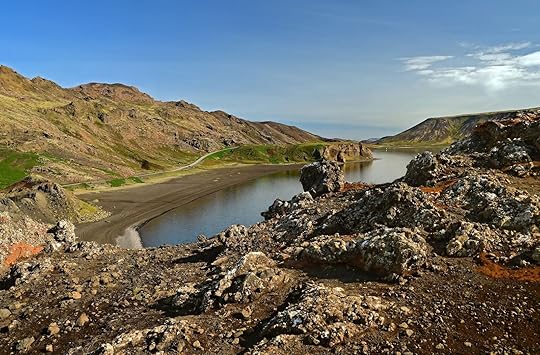
Photo: Nina B /Shutterstock
Another detail that stands out to me about this multi-gen Windstar journey, and one of the reasons my family (and many other younger groups of families who were on this journey with us) chose this voyage, is the Windstar brand’s commitment to sustainability. Cruise ships aren’t traditionally known for being easy on the environment — but since Windstar sails small ships and features more in-depth destinations in their itineraries, the brand has the ability to work with the changing travel climate and the environment, as much as they can.
It costs, on average, $1 billion to build a cruise ship, and around $40 to $200 million to renovate them. Renovating a ship is often cheaper and better for the Earth than building a new one, helping prolong its lifespan and reduce pollution. Renovating a ship can also help bring it up to modern safety and environmental standards, among other benefits.
The ship we sailed on, the 312-guest “Star Pride,” is part of the “250 Million Star Plus Initiative.” This initiative is putting money into making Windstar’s existing ships more efficient, sustainable, larger (bigger suites for guests), updating bathrooms, and adding more tender platforms so guests can get on and off the ships faster. The team is also working to create new spaces on the existing ships (including two new dining venues, like Basil + Bamboo, which is set to open on Star Pride in early 2026) instead of just building new ones. You could take a trip on the exact same ship five years apart and feel like it’s a totally new environment.
Other elements of the initiative across other ships can include fashioning a new spa, building a new infinity pool, upgrading and enlarging the fitness area, and “stretching” the ship to make it larger, flashier, and more modern.
It’s a step forward in the cruise industry, and I look forward to seeing more brands follow Windstar in seeking more sustainable methods of operation and improvement.
Reshaping the demographics of many previously stereotyped vacation models, like cruises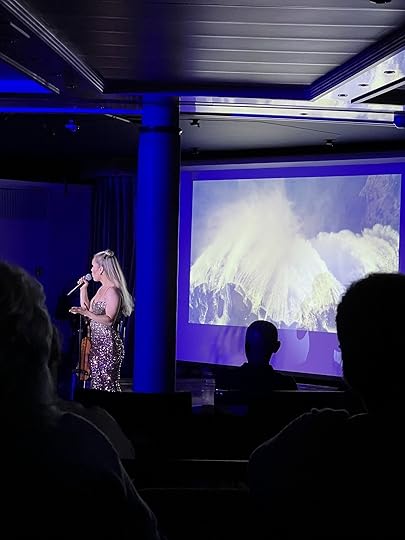
Rocking into the night. Photo: Molly O’Brien
Finally, one of the most important and glaringly obvious details that struck me as different from previous cruise experiences I’ve had is that we weren’t the only multi-gen family on this voyage together. Far from it. Two dozen extended family members from Minnesota came together for this trip, and we’d frequently run into and hang out with their sons, who ranged in age from 14 to 29. There was also a family from Colorado, composed of a mother-father duo and their daughter, who was in her late 20s, along with her husband. No longer are these vacations dominated primarily by wealthy retirees and honeymooners seeking once-in-a-lifetime trips.
It was a much younger crowd onboard than I’d anticipated — and I can see these demographics continuing to shift as more families begin to travel together (especially on cruises). The cruise industry continues to adapt to travelers’ shifting interests and an increase in priority for authentic sustainability initiatives. Folks are increasingly deciding to put their money toward creating special memories together, instead of “saving for later.” Experiences like an unforgettable vacation — rather than material items or an impending inheritance — can be a fantastic way to create precious moments together as a family unit. Since modern families now live geographically further apart than ever, it’s easy to see why a multi-generational vacation on a cruise line like Windstar is an ever-more coveted experience. 
Matador Network's Blog
- Matador Network's profile
- 6 followers



